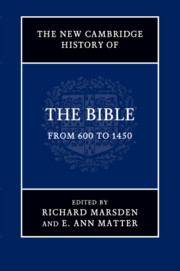Book contents
- Frontmatter
- Contents
- Figures
- Contributors
- Preface
- Abbreviations
- Abbreviations of books of the Bible
- Table of Psalm numbering
- Introduction
- Part I Texts and Versions
- Part II Format and Transmission
- Part III The Bible Interpreted
- 26 Byzantine Orthodox exegesis
- 27 The patristic legacy to c. 1000
- 28 The early schools, c. 900–1100
- 29 The Bible in medieval universities
- 30 Scripture and reform
- 31 Jewish biblical exegesis from its beginnings to the twelfth century
- 32 The Bible in Jewish–Christian dialogue
- 33 The Bible in Muslim–Christian encounters
- Part IV The Bible in Use
- Part V The Bible Transformed
- Bibliography
- Index of biblical manuscripts
- Index of scriptural sources
- General index
- References
30 - Scripture and reform
from Part III - The Bible Interpreted
Published online by Cambridge University Press: 28 May 2012
- Frontmatter
- Contents
- Figures
- Contributors
- Preface
- Abbreviations
- Abbreviations of books of the Bible
- Table of Psalm numbering
- Introduction
- Part I Texts and Versions
- Part II Format and Transmission
- Part III The Bible Interpreted
- 26 Byzantine Orthodox exegesis
- 27 The patristic legacy to c. 1000
- 28 The early schools, c. 900–1100
- 29 The Bible in medieval universities
- 30 Scripture and reform
- 31 Jewish biblical exegesis from its beginnings to the twelfth century
- 32 The Bible in Jewish–Christian dialogue
- 33 The Bible in Muslim–Christian encounters
- Part IV The Bible in Use
- Part V The Bible Transformed
- Bibliography
- Index of biblical manuscripts
- Index of scriptural sources
- General index
- References
Summary
Throughout the church's history reformers have worked to bring the vis-ible church into closer alignment with a scriptural ideal. The Epistle to the Ephesians (5:25–7) indicates that at least one writer within the infant church interpreted the immaculate bride of the Song of Songs, to whom the bridegroom says ‘there is no spot in thee’ (Song 4:7), as a figure for ecclesial perfection. In the understanding of the writer of Ephesians, of the writer of the Apocalypse, of the church fathers and of the western church throughout the Middle Ages, the church in its perfected state was written into the Hebrew scriptures by the man who built the temple at Jerusalem, Solomon son of David, nearly 1,000 years before the birth of Christ. The history of the church, in medieval understanding, was one long struggle to approximate more closely to the stainlessness affirmed by Christ, the bridegroom of the Song of Songs.
In the apostolic and patristic ages, reform typically meant renewal of the individual Christian believer in the image of Christ rather than reform of the body of the church. For Gregory VII, on the other hand, who was pope from 1073 to 1085, reform was principally structural, and was a top-down process. Jean Leclercq argued that the Gregorian reformers, looking to the Bible for authority, too readily related Old Testament narratives to situations never encountered in Jewish history bce, and made the New Testament provide answers to questions never asked in the first century ce. Consequently, in Leclercq's opinion, they interpreted the Old Testament too literally and the New Testament not literally enough. If, however, the eleventh-century reformers sometimes asked the Bible to speak too immediately to the situation of the church they knew (a fault by no means peculiar to them), they were ever aware of the distance between the vexatious imperfections of the visible body and the perfect church inscribed in Jewish and Christian scripture.
- Type
- Chapter
- Information
- The New Cambridge History of the Bible , pp. 579 - 595Publisher: Cambridge University PressPrint publication year: 2012
References
- 1
- Cited by

